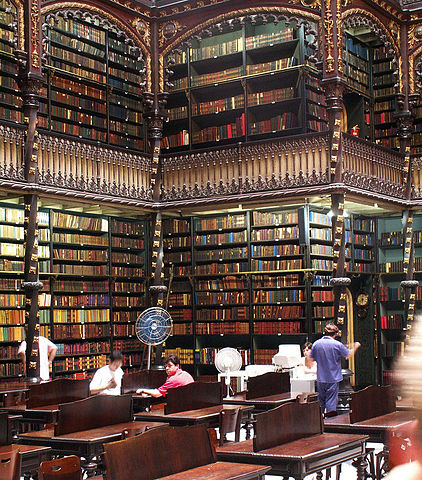The Royal Portuguese Reading Room, Brazil

Built in 1887, the Royal Portuguese Reading Room in Rio de Janeiro, Brazil is a showplace, containing a chandelier and an iron skylight. The Royal Portuguese Library association in Brazil was founded even earlier, in 1837. Immigrants from Portugal who were working as merchants in Rio de Janeiro wanted to celebrate their native culture. They hired a Portuguese architect to create this elaborate structure. As you may know, a variety of Portuguese is spoken in Brazil. Portuguese is the fifth major language in the world. Due to the long history of colonization of Portugal in other parts of the world, the Portuguese language is spoken by Brazilians and Portuguese as well as by the people of Cape Verde, Mozambique and Macau, among other places. In the last-mentioned place, Portuguese is the official language, along with Chinese.
In all of these places, the language spoken is quite different, even if people from different parts of the Portuguese-speaking world can usually understand each other. The difference between Brazilian Portuguese and the Portuguese spoken in Portugal is much greater than the difference between American and British English. Brazilian Portuguese has played an important role in the world because of that country’s famous popular music and also its popular television soap operas.
The reading room’s structure and content.
The reading room has two floors and was the first building in Rio to have a metallic structure. The outside of the building is decorated with sculptures in limestone, while the inside features the high-ceilinged reading room with galleries containing bookshelves. Stained glass windows provide lighting. It took seven years to complete, and has the finest collection of Portuguese works outside of Portugal, with over 350,000 volumes. If you are interested to trying to sample some Brazilian culture, you can look at some of the books in the TU Libraries collection. If you are curious about Brazilian music, you can try The Billboard book of Brazilian music: Samba, bossa nova and the popular sounds of Brazil or The mystery of samba: popular music and national identity in Brazil.
If you love football, you may enjoy Pelé: the autobiography, the life story of the legendary athlete. If you enjoy reading fiction, you might like the novels of Brazil’s greatest writer, Machado de Assis, who has been called a tragic comedian.
Thailand and Brazil
It is worthwhile for Thai people to learn a little bit about Brazil. As His Excellency Paulo Vasconcellos, Ambassador of Brazil to the Kingdom of Thailand said in a speech in Bangkok in 2013:
“Thailand and Brazil have a lot in common.” Ambassador Vasconcellos pointed out that Thailand and Brazil established diplomatic relations in 1959, but although the people of both countries have a good opinion of each other, little is known in Thailand about Brazil and vice versa. The ambassador notes: “[When] people in Brazil talk about Thailand they imagine Thai people riding elephants, and when we talk about Brazil here Thai people just think of football, but there is much more.”
What Brazilians and Thai people have in common.
To begin with, there is important trade and investment exchanged between the two countries. In 2012, bilateral trade amounted to US$4.7 billion [Bt146 billion], far more than the bilateral trade between Brazil and its neighboring countries in South America. Ambassador Vasconcellos suggested that
Thai businessmen should go to Brazil more often and vice versa to learn about the business opportunities.
Brazilian firms participate in agricultural and food products fairs in Bangkok. One major Brazilian export to Thailand is soybeans. Iron and steel products, auto parts, medicine, fine chemicals, and rare minerals are also imported from Brazil to Thailand. Whereas Thai auto parts are a major export to Brazil, followed by tires and rubber products, electronics, textiles, and artificial fibers. Mutual investments have yet to be strongly developed. In 2012, about 30,000 Brazilian tourists visited Thailand and that rate is increasing. Only 5,000 Thais visited Brazil, perhaps because one reason that people go to Brazil is to visit beaches, and Thailand already features many fine beaches. Since the climates of Thailand and Brazil are similar, Ambassador Vasconcellos observes, the two countries share agricultural products in common. Brazil is the world’s largest producer of sugar cane, while Thailand is the second-largest:
In agriculture, we work together in rice production, research, sugar cane, cotton, fruit and other farm products due to similar climatic conditions.
(all images courtesy of Wikimedia Commons).



